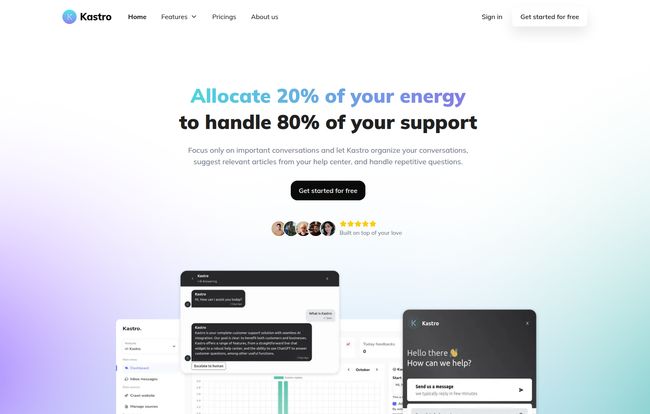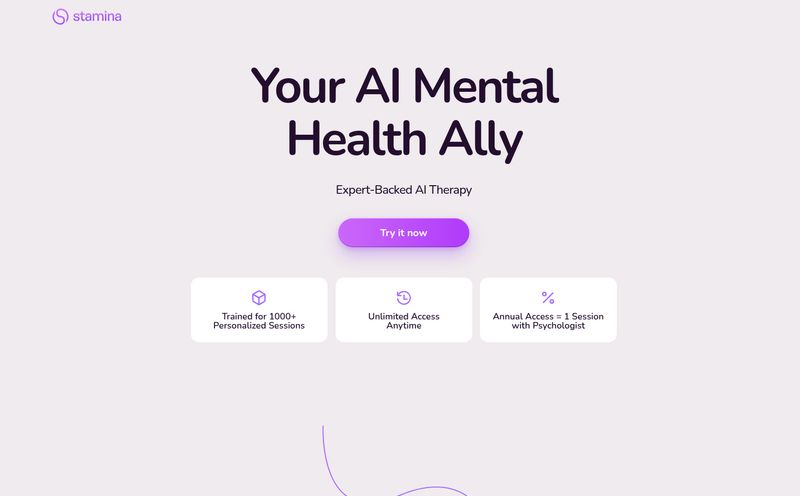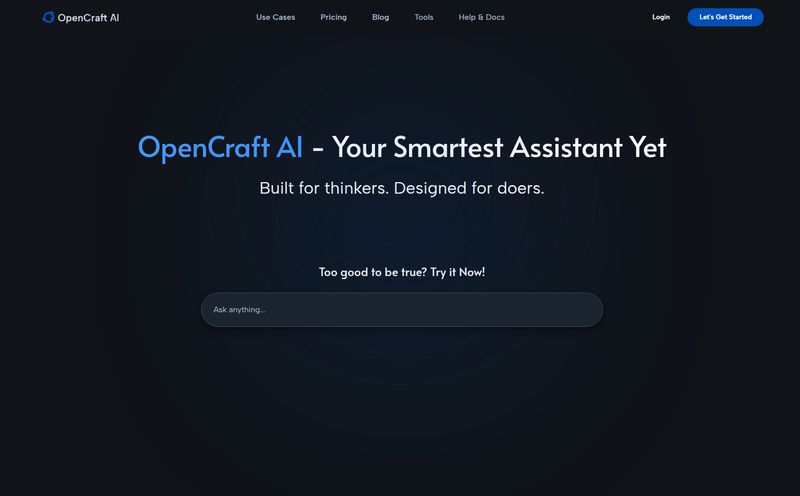Let’s have a little chat. If you’ve ever run a startup, an indie project, or even just a moderately successful blog, you know the feeling. The thrill of getting customers is quickly followed by the... well, the grind of supporting them. It starts with a trickle of emails. Then it becomes a stream. Before you know it, you're spending your mornings answering the same three questions over and over again, and your great big plans for product development are gathering dust.
We've all been there. I remember one project where I felt more like a human FAQ page than a founder. It’s a soul-crushing bottleneck. For years, the solution was either to hire someone (expensive!) or to just suck it up. But the AI boom has changed the game, and tools like Kastro are popping up, promising to be the solution we’ve been waiting for.
But is it just more tech hype? Or is it genuinely a life raft for overloaded entrepreneurs? I’ve spent some time digging into it, and honestly, I'm pretty impressed. Kastro’s homepage hits you with a bold claim: “Allocate 20% of your energy to handle 80% of your support.” That’s the Pareto principle staring you right in the face, and as a productivity nerd, I was immediately hooked.
So What Exactly Is Kastro? (And Why Should You Care?)
Kastro isn't just another chatbot widget you slap on your site. It brands itself as an “AI-first customer support solution,” and that distinction matters. It’s built from the ground up with a ChatGPT brain, designed specifically for the little guys—startups and indie hackers who don’t have a 20-person support team or a bottomless budget.
Think of it less as a robot and more as a tireless junior support agent. One that you can train instantly, works 24/7 without coffee breaks, and happily handles the mountain of repetitive, low-level questions that clog up your inbox. This frees you, or your small team, to focus on the complex, high-value conversations that actually move the needle. You know, the ones that require a real human touch.

Visit Kastro
A Look Under the Hood at Kastro's Core Features
Okay, so it sounds good on paper. But what are you actually getting? I've found that the platform is built around a few really smart, interconnected components.
The GPT Chatbot: Your Tireless Frontline
This is the star of the show. The chatbot is what your customers will see first. It connects directly to a knowledge base that you create (more on that in a sec) and provides instant answers. Someone asking about your refund policy at 3 AM? The bot’s got it. Someone wondering how to reset their password for the tenth time today? The bot doesn’t mind. It's your first line of defense, filtering out the noise so you can focus on the signal.
The AI Workspace: Making Your Human Agents Superhuman
This is where Kastro gets really clever, in my opinion. It’s not just about deflecting tickets; it’s about making the human part of support faster and better. When a question is too tricky for the AI and gets escalated to a person, the AI doesn't just clock out. It hangs around to help. The AI Workspace offers things like typing suggestions and quick replies based on your past conversations and help center articles. It turns a good support agent into a lightning-fast one. It's a genuine collaboration between human and machine, and it’s something I think we'll see a lot more of.
The Help Center & Website Crawler: The Brain of the Operation
An AI is only as smart as the data it’s trained on. This is a universal truth. Kastro’s intelligence comes from its Help Center, which is your knowledge base of articles, guides, and FAQs. Now, the thought of migrating your entire existing FAQ page might make you want to lie down. I get it. But Kastro has a killer feature: a Website Crawler. You just give it a URL, and it automatically pulls in your content to build out the knowledge base. This is a massive time-saver and removes one of the biggest hurdles to adopting a tool like this. Honestly, what a relief.
Let's Talk Money: The Kastro Pricing Plans
Alright, the all-important question. How much does this magic cost? The pricing structure seems designed to grow with you, which is exactly what a startup needs. No one wants to sign a massive enterprise contract on day one.
| Plan | Price/Month | Who It's For | Key Features |
|---|---|---|---|
| Free | $0 | The Curious Tester | 1 website, 100 one-time AI credits, 50 help articles. Perfect for a no-risk trial run. |
| Starter | $35 | The Solopreneur / Small Project | 1 website, 2,000 monthly credits, 100 articles, typing suggestions. This is the real entry point. |
| Professional | $75 | The Growing Startup | 3 websites, 5,000 monthly credits, 200 articles. Their “Most Popular” plan for a reason. |
| Elite | $275 | The Scaling Business | 10 websites, 20,000 credits, unlimited articles, GPT-4 access, no Kastro branding, priority support. |
My take? The Free plan is a true free plan—enough to see if you like the interface without pulling out your credit card. The Starter plan is where you get serious, and the Professional plan feels like the sweet spot for a small team that’s starting to feel the support pressure. The jump to Elite is steep, but it unlocks GPT-4 and removes branding, which is a must for established companies.
The Good, The Bad, and The AI
No tool is perfect, right? Here’s my breakdown of where Kastro shines and where you might feel a little pinch.
What I Really Like About Kastro
First off, the cost-to-value ratio is fantastic. For $35 a month, you can automate a significant chunk of your support overhead. That’s less than a few hours of a freelancer's time. The ease of setup, mainly thanks to that website crawler, is a huge win. The focus on augmenting human agents, not just replacing them, feels like the right approach. It’s pragmatic. Plus, the interface is clean and simple. You won't need a PhD to figure it out, which is more than I can say for some of its bigger, more bloated competitors.
Where It Could Be Better
Let's be real. The AI is powerful, but it's not a mind reader. If your help documentation is sparse or poorly written, the AI's answers will be too. It relies on you to provide it a good brain. The message credit system, while common, is something to watch. If you have a huge traffic spike, you could burn through them faster than expected. And, of course, walling off GPT-4 access to the most expensive tier is a classic SaaS move. It makes business sense for them, but it’s a bummer for smaller teams who could benefit from the more advanced model's reasoning capabilities.
Kastro vs. The Goliaths: A Quick Showdown
You might be thinking, “How does this stack up against something like Intercom?” It's a fair question. On their own pricing page, Kastro puts itself up against Intercom, Chatbase, and SiteGPT. I love that transparency.
Here’s the thing: Intercom is a beast. It’s a full-blown customer communications platform with a price tag to match. For many startups, it's like using a sledgehammer to crack a nut. Kastro isn't trying to be Intercom. It’s a focused, sharp tool designed to solve one problem extremely well: automating frontline support. It’s leaner, meaner, and way more affordable. It knows its niche, and I respect that.
Frequently Asked Questions About Kastro
- Can I actually try Kastro before buying?
- Yep! They have a $0 free plan that gives you 100 AI credits to kick the tires and see how it feels. No credit card required, which is always a good sign.
- What happens if I run out of my monthly message credits?
- Your bot will likely stop responding until your plan renews the next month. You'd either have to wait or upgrade to a higher tier with more credits to get it running again immediately.
- Is GPT-4 really that much better than GPT-3.5 for this?
- In my experience, for standard FAQ stuff, GPT-3.5 is perfectly fine and very fast. GPT-4 is a bit slower but excels at understanding more complex, multi-part questions with more nuance. For most users starting out, 3.5 is more than enough.
- How hard is it to set up, really?
- Honestly, it’s one of the easier setups I’ve seen. If you have an existing FAQ or documentation page, the website crawler does most of the heavy lifting. After that, it’s just a matter of pasting a small code snippet onto your website. You could be up and running in less than an hour.
- Does my company need a custom integration?
- For most, no. But the Elite plan does offer custom integrations. This is for larger companies that might need Kastro to talk to their internal CRM or other proprietary software.
My Final Verdict on Kastro
So, is Kastro the future of customer support? For startups, indie hackers, and small businesses, it just might be. It’s a sharp, focused, and affordable tool that tackles a very real, very painful problem.
It’s not going to solve every complex customer issue, and it’s not meant to. What it does is build a protective moat around your most valuable resource: your time and energy. It handles the repetitive floods so you can focus on building bridges with your customers. If you're a small team feeling buried under the weight of your support inbox, I think giving Kastro’s free plan a spin is a no-brainer. It could be the best hire you make all year.



